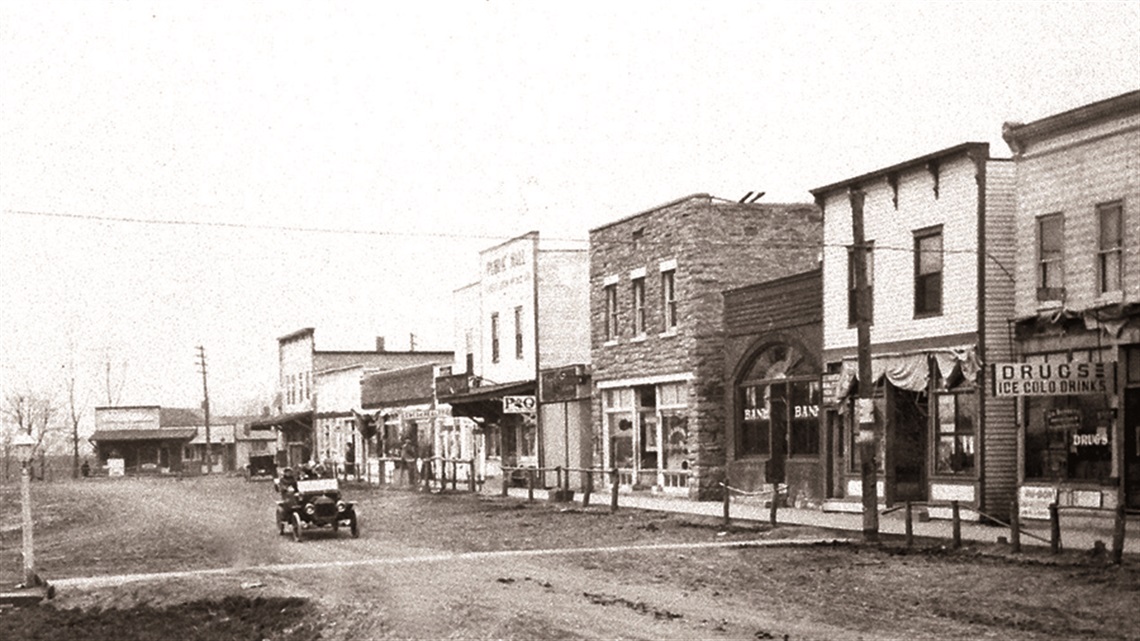Lenexa History

Platted in 1869, the original site for Lenexa was only 42 acres. Lenexa has grown over the decades and now encompasses 34.5 square miles. For many years, Lenexa was a farming community which used the depot to export their goods.
Founding of Lenexa
Lenexa was platted in 1869 by civil engineer Octave Chanute. The original 42 acres of land was purchased from Squire Charles A. Bradshaw’s 160-acre fruit farm for $1,100.
Transportation has always been a key element of Lenexa’s growth and a railroad depot was built shortly after the town was platted. The depot had a lasting impact on the landscape, economy and the people of Lenexa. The land for the depot was granted to the Missouri Fort Scott & Gulf Railroad company for $1 by Bradshaw. As part of the deal, Bradshaw insisted the railroad keep an operating depot in Lenexa or they would forfeit their right to the land. Lenexa still has a rail depot, located near the intersection of Santa Fe Trail Drive and Pflumm Road. The 1912 depot was moved to Sar-Ko-Par Trails Park and refurbished into a museum.
Lenexa was officially incorporated in 1907.
Lenexa’s namesake
In our area, there are many indigenous tribes with long histories. Lenexa got its name from a member of the Shawnee Nation, a woman named Na-Nex-Se.
Back in 1825, the Shawnee Nation made an agreement with the government. They gave up their land in Ohio, and in return, they got 1.6 million acres of land in the Kansas Territory. A lot of that land was in Johnson County. Na-Nex-Se and her family moved to Kansas after this agreement. When they moved to Kansas, the Shawnee established American-style farms complete with fruit orchards.
There are several spellings of her name, and few facts are known about her. Census records indicate she was the wife of Chief Black-hoof and she maintained their farm after the death of her husband. It is believed that she was educated in a Christian school in Ohio when she was young. According to early town residents, one of the original founders was a modest man and declined the offer for the city to be named after him. Instead, he suggested the town be named after Ne-Nex-Se. If the altered spelling was intentional or by accident is also unknown. We continue to honor Na-Nex-Se’s legacy today with the sculpture that stands outside City Hall.
From the 1830s to mid-1850s non-natives were not allowed to move to Kansas unless they were on official government business or were missionaries, but many passed through on the historic trails for trading or for moving to the west coast.
Historic trails
Lenexa’s proximity to the starting point of the historic trails had a big influence on its geographical location. Westport, Missouri, was where many travelers disembarked from steamboats coming from the east to begin their journey on the Santa Fe, Oregon and California Trails.
The Santa Fe Trail, founded in the 1820s, crossed through the southeast part of present-day Lenexa. Southwest of Lenexa, the trail split to go north and turned into the Oregon and California trails. Flat Rock Creek, near present day 103rd & Pflumm, was a day’s walk from Westport, Missouri. This was a prime location for setting up for the first night of camp. As the pioneers embarked on this perilous journey, the creek became a serene location to plan their journey.
Kansas territory to statehood
In 1854, big changes took place in Kansas with the signing of the Kansas-Nebraska Act, which set the ground rules for territories becoming states. This act allowed Americans and other immigrants to legally move to Kansas Territory. The Kansas-Nebraska Act was a leading cause of the Civil War. Many people moved to Kansas to establish a government so the territory could become a state. There was great tension and violence during this period as Jayhawkers and Bushwhackers flooded the state. This period of conflict between pro-slavery and anti-slavery forces is called Bleeding Kansas. Kansas became a free state on January 29, 1861. The Civil War officially broke out on April 12, 1861, and ended on April 9, 1865.
Spinach capital to suburban community
In the 1930s, Lenexa became known as the "Spinach Capital of the World" for the impressive amount of spinach farmers in the area were able to export using the depot. Many of these farmers were immigrants from eastern states and Europe, including countries like Germany, Switzerland and Belgium.
Each fall, the community comes together for the Spinach Festival. This event is a way to celebrate the town's history in farming, especially its connection to spinach. It's a time to remember and honor the agricultural traditions of Lenexa.
Lenexa’s population at the time of incorporation in 1907 was just 362. By 1930 the population had only increased to 452. The depot continued to be a distribution center for area farms and fruit orchards until the 1960s. Growth was steadier over the next twenty years and by 1970 Lenexa’s population was 5,242. The coming decades saw Lenexa’s population grow exponentially, often being the fastest growing city in Kansas.
View a map of annexations by year
History videos: Look back at the past
Learn about the people, places and events that shaped Lenexa in this history video series.